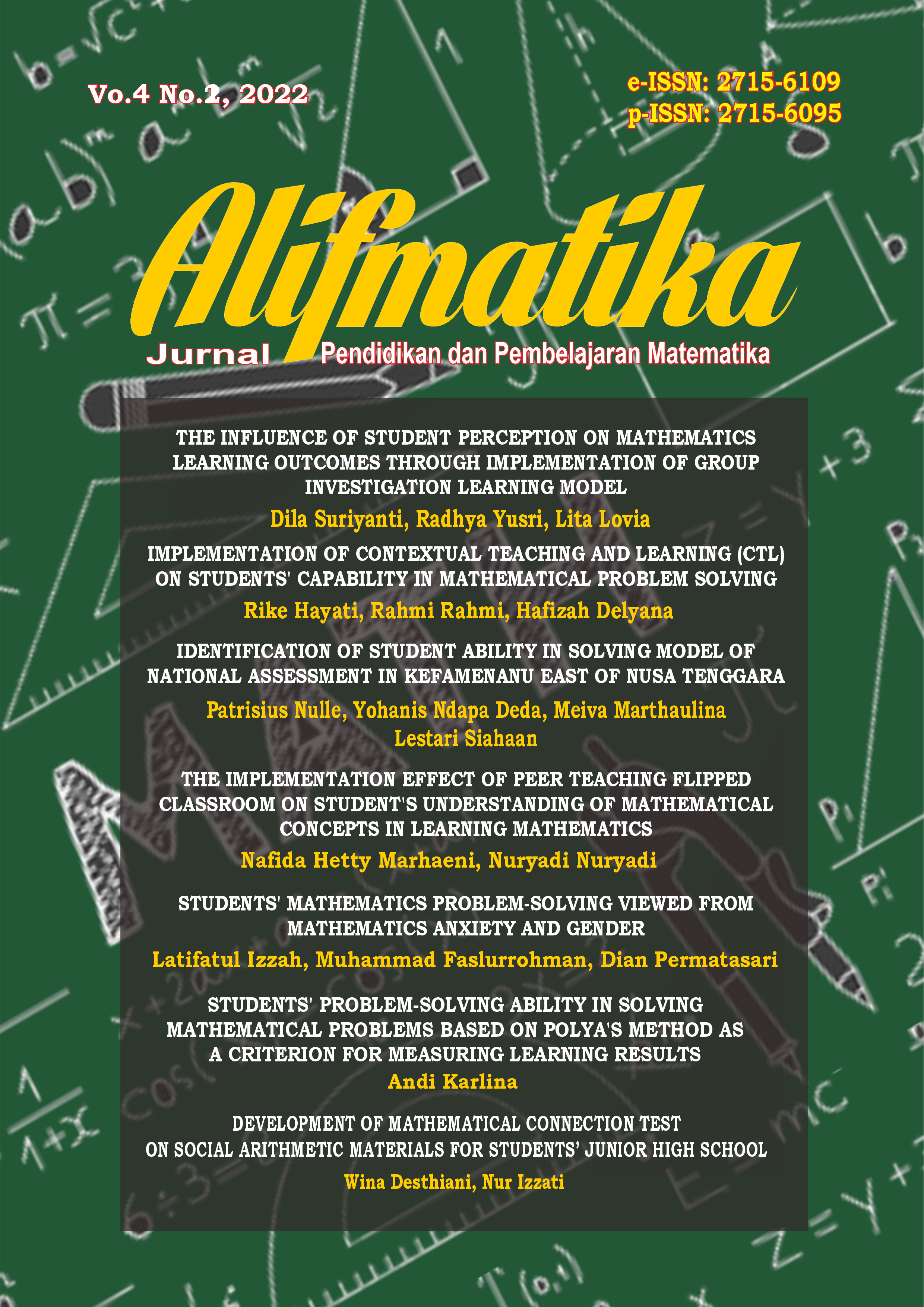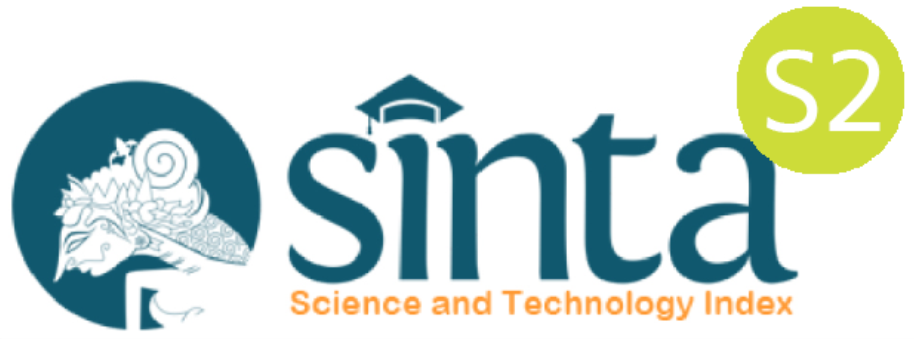DEVELOPMENT OF MATHEMATICAL CONNECTION TEST ON SOCIAL ARITHMETIC MATERIALS FOR STUDENTS’ JUNIOR HIGH SCHOOL
DOI:
https://doi.org/10.35316/alifmatika.2022.v4i2.192-204Keywords:
Instrument test, mathematical connectionsAbstract
This study aims to find out the procedure and assess the quality of developing test instruments to measure students' mathematical connection abilities. Students seemed lacking in answering questions to develop their mathematical connection ability, therefore it is necessary to practice questions to measure students' mathematical connection abilities. This research is a research and development research and development under formative research model that conducted through four sreps. The data collection instruments in this study were validation sheets and test instruments. The test subjects in this study were 10 students. The results obtained from the content validity test were declared valid because the CVR and CVI values were 1 which refer to very appropriate categories. The reliability of the instrument is declared reliable, where the reliability value is 0.815 which referred to a high reliability or consistency interpretation. Meanwhile, in terms of difficulty level, the average total score is 0.36 in the intermediate category. In terms of discriminating power, the average total score is 0.40 which refer to the good category. Thus, the developed mathematical connection ability test instrument has fulfilled to be a good quality.
Downloads
References
Abidin, Z., & Tohir, M. (2019). Keterampilan Berpikir Tingkat Tinggi dalam Memecahkan Deret Aritmatika Dua Dimensi Berdasarkan Taksonomi Bloom. Alifmatika: Jurnal Pendidikan Dan Pembelajaran Matematika, 1(1), 44–60. https://doi.org/10.35316/alifmatika.2019.v1i1.44-60
Adni, D. N., Nurfauziah, P., & Rohaeti, E. E. (2018). Analisis kemampuan koneksi matematis siswa SMP ditinjau dari self efficacy siswa. JPMI (Jurnal Pembelajaran Matematika Inovatif), 1(5), 957–964. https://doi.org/10.22460/jpmi.v1i5.p957-964
Agustini, R. Y., Suryadi, D., & Jupri, A. (2017). Construction of open-ended problems for assessing elementary student mathematical connection ability on plane geometry. Journal of Physics: Conference Series, 895(1), 12148. https://doi.org/10.1088/1742-6596/895/1/012148
Aida, N., Kusaeri, K., & Hamdani, A. S. (2017). Karakteristik instrumen penilaian hasil belajar matematika ranah kognitif yang dikembangkan mengacu pada model PISA. Suska; Journal of Mathematics Education, 3(2), 130–139. http://repository.uinsby.ac.id/id/eprint/302/
Angriani, A. D., Nursalam, N., & Batari, T. (2018). Pengembangan Instrumen Tes Untuk Mengukur Kemampuan Koneksi Matematis. AULADUNA: Jurnal Pendidikan Dasar Islam, 5(1), 1–12. https://doi.org/10.24252/auladuna.v5i1a1.2018
Diana, N., Suryadi, D., & Dahlan, J. A. (2020). Analysis of students’ mathematical connection abilities in solving problem of circle material: transposition study. Journal for the Education of Gifted Young Scientists, 8(2), 829–842.
Furqoni, A. N., & Destania, Y. (2020). Pengembangan Soal Statistika untuk Meningkatkan Kemampuan Koneksi Matematis Siswa. Alifmatika: Jurnal Pendidikan Dan Pembelajaran Matematika, 2(2), 212–228. https://doi.org/10.35316/alifmatika.2020.v2i2.212-228
Kenedi, A. K., Helsa, Y., Ariani, Y., Zainil, M., & Hendri, S. (2019). Mathematical Connection of Elementary School Students to Solve Mathematical Problems. Journal on Mathematics Education, 10(1), 69–80. https://doi.org/10.22342/jme.10.1.5416.69-80
Menanti, H., & Sinaga, B. (2018). Improve Mathematical Connections Skills with Realistic Mathematics Education Based Learning. 3rd Annual International Seminar on Transformative Education and Educational Leadership (AISTEEL 2018), 29–35. https://doi.org/10.2991/aisteel-18.2018.7
Munawwarah, M., Laili, N., & Tohir, M. (2020). Keterampilan Berpikir Kritis Mahasiswa dalam Memecahkan Masalah Matematika Berdasarkan Keterampilan Abad 21. Alifmatika: Jurnal Pendidikan Dan Pembelajaran Matematika, 2(1), 37–58. https://doi.org/10.35316/alifmatika.2020.v2i1.37-58
NCTM. (2000). Principles and Standards for School Mathematics. United States of America: The National Council of Teacher of Mathematics, Inc. National Council of Teachers of Mathematics. https://www.nctm.org/uploadedFiles/Standards_and_Positions/PSSM_ExecutiveSummary.pdf
Purwanto, P. (2018). Teknik Penyusunan Instrumen Uji Validitas Dan Reliabilitas Penelitian Ekonomi Syariah. Stiapress. http://www.staia-sw.ac.id/2020/05/teknik-penyusunan-instrumen-uji.html
Rahmi, M., & Subianto, M. (2020). First-grade junior high school students’ mathematical connection ability. Journal of Physics: Conference Series, 1460(1), 12003. https://doi.org/10.1088/1742-6596/1460/1/012003
Rosyana, T., & Sari, I. P. (2015). Penerapan Aktivitas Quick On The Draw Melalui Pendekatan Thinking Aloud Pair Problem Solving Untuk Meningkatkan Kemampuan Komunikasi Dan Penalaran Matematis Siswa MA. Jurnal Ilmiah P2M STKIP Siliwangi, 2(2), 192–202. https://doi.org/10.22460/p2m.v2i2p192-202.178
Sa’dijah, C., Sa’diyah, M., Sisworo, & Anwar, L. (2020). Students’ mathematical dispositions towards solving HOTS problems based on FI and FD cognitive style. AIP Conference Proceedings, 2215(1), 60025. https://doi.org/10.1063/5.0000644
Setyoningrum, A., Sukestiyarno, Y. L., & Nugroho, S. E. (2020). The Development of Independent Learning Through Brain Based Learning Assistance to Improve Grit and Mathematical Connection Ability. Journal of Primary Education, 9(2), 152–160. https://journal.unnes.ac.id/sju/index.php/jpe/article/view/36382
Slameto, S., Sulasmono, B. B. S., & Wardani, K. K. W. (2017). Customer Satisfaction Reviewed from Problem Based Learning, Leadership and Alumni Concern. 2nd International Conference on Educational Management and Administration (CoEMA 2017), 232–236. https://doi.org/10.2991/coema-17.2017.41
Sugiyono, S. (2017). Metode Penelitian Bisnis: Pendekatan Kuantitatif, Kualitatif, Kombinasi, dan R&D. Penerbit CV. Alfabeta: Bandung. https://cvalfabeta.com/product/metode-penelitian-bisnis-pendekatan-kuantitatif-kualitatiff-kombinasi-dan-rd/
Tohir, M., Maswar, M., Atikurrahman, M., Saiful, S., & Pradita, D. A. R. (2020). Prospective teachers’ expectations of students’ mathematical thinking processes in solving problems. European Journal of Educational Research, 9(4), 1735–1748. https://doi.org/10.12973/eu-jer.9.4.1735
Widiyawati, W., Septian, A., & Inayah, S. (2020). Analisis kemampuan koneksi matematis siswa SMK pada materi trigonometri. Jurnal Analisa, 6(1), 28–39. https://doi.org/10.15575/ja.v6i1.8566
Zulfa, A., Yusmin, E., & Bistari, B. (2018). Kemampuan Koneksi Matematis Siswa Dalam Menyelesaikan Soal Cerita Bilangan Bulat Di SMP Negeri 2 Sungai Raya. Jurnal Pendidikan Dan Pembelajaran Khatulistiwa, 7(7), 1–14. https://doi.org/10.26418/jppk.v7i7.26824
Downloads
Published
How to Cite
Issue
Section
License
COPYRIGHT NOTICE
Author (s) who publish in Alifmatika: Jurnal Pendidikan dan Pembelajaran Matematika agree to the following terms:
- The Author (s) submitting a manuscript do so on the understanding that if accepted for publication, copyright of the article shall be assigned to Alifmatika: Jurnal Pendidikan dan Pembelajaran Matematika, Tarbiyah Faculty of Ibrahimy University as the publisher of the journal. Consecutively, author(s) still retain some rights to use and share their own published articles without written permission from Alifmatika: Jurnal Pendidikan dan Pembelajaran Matematika. This work is licensed under a Creative Commons Attribution-ShareAlike 4.0 International License.
- Copyright encompasses rights to publish and provide the manuscripts in all forms and media for the purpose of publication and dissemination, and the authority to enforce the rights in the manuscript, for example in the case of plagiarism or in copyright infringement.
- Alifmatika: Jurnal Pendidikan dan Pembelajaran Matematika and the Editors make every effort to ensure that no wrong or misleading data, opinions or statements be published in the journal. In any way, the contents of the articles and advertisements published in Alifmatika: Jurnal Pendidikan dan Pembelajaran Matematika are the sole responsibility of their respective authors and advertisers.
- The Copyright Transfer Form can be downloaded here [Copyright Transfer Form Alifmatika]. The copyright form should be signed originally and send to the Editorial Office in the form of original mail, scanned document to alifmatika[at]ibrahimy.ac.id or upload the scanned document in the comments column when sending the manuscript.























_by_Matematohir.jpg)






